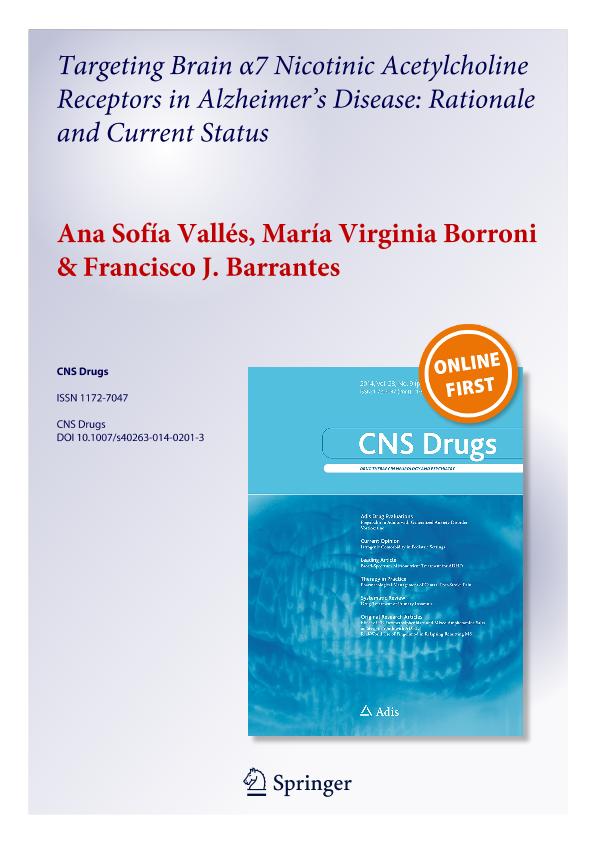Mostrar el registro sencillo del ítem
dc.contributor.author
Valles, Ana Sofia

dc.contributor.author
Borroni, Maria Virginia

dc.contributor.author
Barrantes, Francisco Jose

dc.date.available
2017-03-02T18:26:22Z
dc.date.issued
2014-11
dc.identifier.citation
Valles, Ana Sofia; Borroni, Maria Virginia; Barrantes, Francisco Jose; Targeting Brain α7 Nicotinic Acetylcholine Receptors in Alzheimer's Disease: Rationale and Current Status.; Springer; Cns Drugs; 28; 11; 11-2014; 975-987
dc.identifier.issn
1172-7047
dc.identifier.uri
http://hdl.handle.net/11336/13476
dc.description.abstract
Alzheimer’s disease (AD) is the most common form of dementia among older persons. Pathognomonic hallmarks of the disease include the development of amyloid senile plaques and deposits of neurofibrillary tangles. These changes occur in the brain long before the clinical manifestations of AD (cognitive impairment in particular) become apparent. Nicotinic acetylcholine receptors (AChRs), particularly the α7 subtype, are highly expressed in brain regions relevant to cognitive and memory functions and involved in the processing of sensory information. There is strong evidence that implicates the participation of AChRs in AD. This review briefly introduces current strategies addressing the pathophysiologic findings (amyloid-β-peptide plaques, neurofibrillary tangles) and then focuses on more recent efforts of pharmacologic intervention in AD, specifically targeted to the α7 AChR. Whereas cholinesterase inhibitors such as donepezil, galantamine, or rivastigmine, together with the non-competitive N-methyl-d-aspartate receptor antagonist memantine are at the forefront of present-day clinical intervention for AD, new insights into AChR molecular pharmacology are bringing other drugs, directed at AChRs, to center stage. Among these are the positive allosteric modulators that selectively target α7 AChRs and are aimed at unleashing the factors that hinder agonist-mediated, α7 AChR channel activation. This calls for more detailed knowledge of the distribution, functional properties, and involvement of AChRs in various signaling cascades—together with the corresponding abnormalities in all these properties—to be able to engineer strategies in drug design and evaluate the therapeutic possibilities of new compounds targeting this class of neurotransmitter receptors.
dc.format
application/pdf
dc.language.iso
eng
dc.publisher
Springer

dc.rights
info:eu-repo/semantics/openAccess
dc.rights.uri
https://creativecommons.org/licenses/by-nc-sa/2.5/ar/
dc.subject
Alzheimer
dc.subject
Nicotinic Acetylcholine Receptor
dc.subject
Pam
dc.subject.classification
Neurociencias

dc.subject.classification
Medicina Básica

dc.subject.classification
CIENCIAS MÉDICAS Y DE LA SALUD

dc.title
Targeting Brain α7 Nicotinic Acetylcholine Receptors in Alzheimer's Disease: Rationale and Current Status.
dc.type
info:eu-repo/semantics/article
dc.type
info:ar-repo/semantics/artículo
dc.type
info:eu-repo/semantics/publishedVersion
dc.date.updated
2017-03-01T17:48:44Z
dc.identifier.eissn
1179-1934
dc.journal.volume
28
dc.journal.number
11
dc.journal.pagination
975-987
dc.journal.pais
Suiza

dc.journal.ciudad
Zurich
dc.description.fil
Fil: Valles, Ana Sofia. Consejo Nacional de Investigaciones Cientificas y Técnicas. Centro Científico Tecnológico Bahia Blanca. Instituto de Investigaciones Bioquímicas Bahia Blanca (i); Argentina
dc.description.fil
Fil: Borroni, Maria Virginia. Consejo Nacional de Investigaciones Científicas y Técnicas. Centro Científico Tecnológico Bahía Blanca. Planta Piloto de Ingeniería Química (i); Argentina
dc.description.fil
Fil: Barrantes, Francisco Jose. Pontificia Universidad Católica Argentina "santa María de Los Buenos Aires". Facultad de Ciencias Médicas. Instituto de Investigaciones Biomédicas; Argentina
dc.journal.title
Cns Drugs

dc.relation.alternativeid
info:eu-repo/semantics/altIdentifier/url/https://link.springer.com/article/10.1007%2Fs40263-014-0201-3
dc.relation.alternativeid
info:eu-repo/semantics/altIdentifier/doi/http://dx.doi.org/10.1007/s40263-014-0201-3
Archivos asociados
